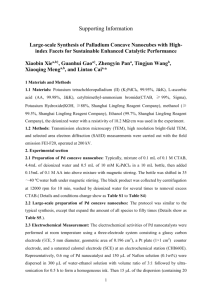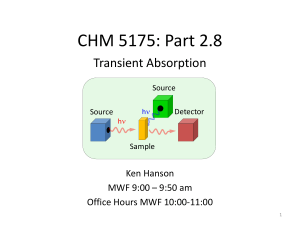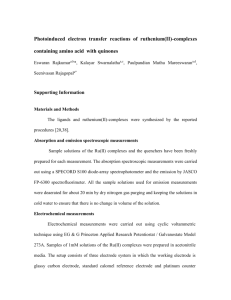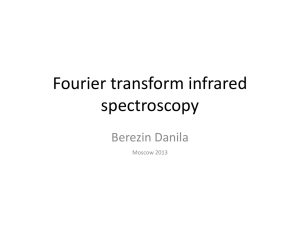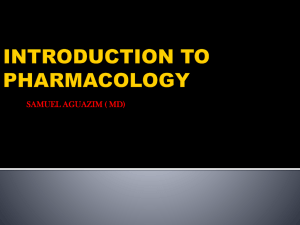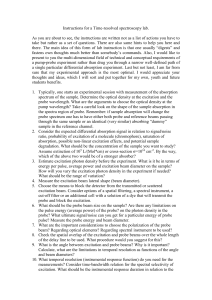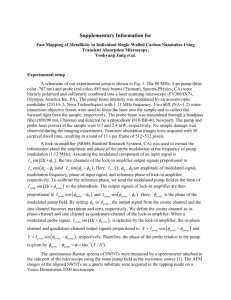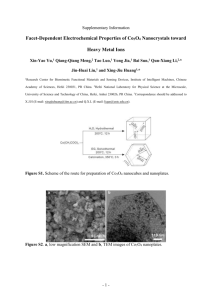EPAPS_Lee - AIP FTP Server
advertisement
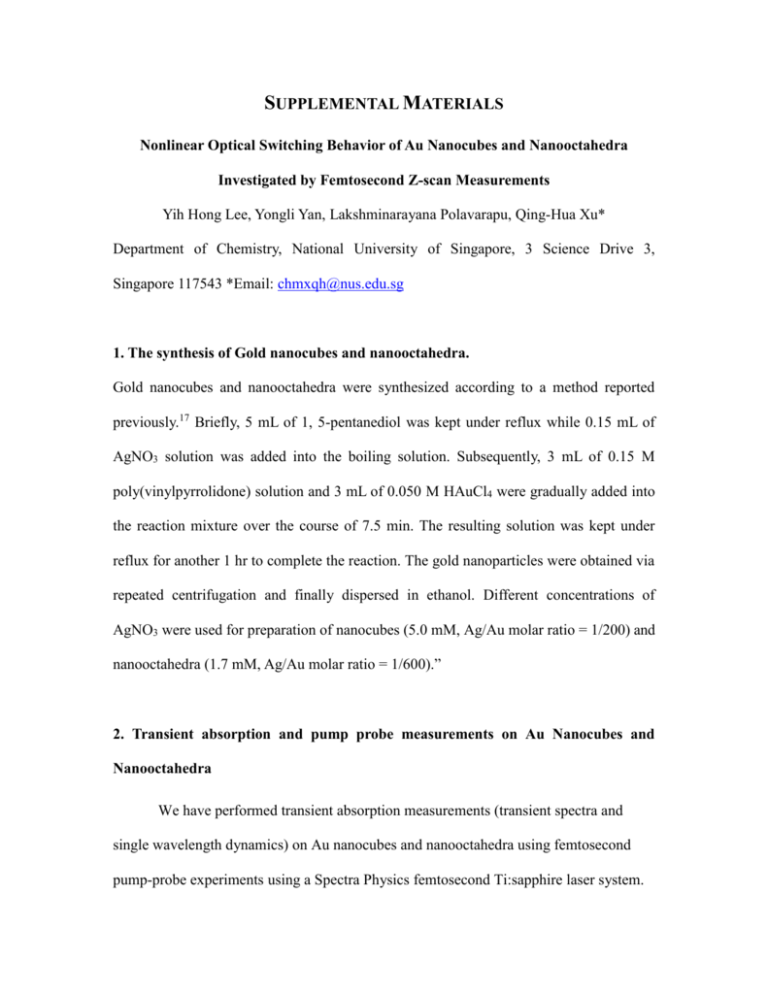
SUPPLEMENTAL MATERIALS Nonlinear Optical Switching Behavior of Au Nanocubes and Nanooctahedra Investigated by Femtosecond Z-scan Measurements Yih Hong Lee, Yongli Yan, Lakshminarayana Polavarapu, Qing-Hua Xu* Department of Chemistry, National University of Singapore, 3 Science Drive 3, Singapore 117543 *Email: chmxqh@nus.edu.sg 1. The synthesis of Gold nanocubes and nanooctahedra. Gold nanocubes and nanooctahedra were synthesized according to a method reported previously.17 Briefly, 5 mL of 1, 5-pentanediol was kept under reflux while 0.15 mL of AgNO3 solution was added into the boiling solution. Subsequently, 3 mL of 0.15 M poly(vinylpyrrolidone) solution and 3 mL of 0.050 M HAuCl4 were gradually added into the reaction mixture over the course of 7.5 min. The resulting solution was kept under reflux for another 1 hr to complete the reaction. The gold nanoparticles were obtained via repeated centrifugation and finally dispersed in ethanol. Different concentrations of AgNO3 were used for preparation of nanocubes (5.0 mM, Ag/Au molar ratio = 1/200) and nanooctahedra (1.7 mM, Ag/Au molar ratio = 1/600).” 2. Transient absorption and pump probe measurements on Au Nanocubes and Nanooctahedra We have performed transient absorption measurements (transient spectra and single wavelength dynamics) on Au nanocubes and nanooctahedra using femtosecond pump-probe experiments using a Spectra Physics femtosecond Ti:sapphire laser system. The laser pulses were generated from a mode-locked Ti:sapphire oscillator seeded regenerative amplifier with a pulse energy of 2 mJ at 800 nm and a repetition rate of 1 kHz. The 800 nm laser beam was split into two portions. The larger portion of the beam was passed through a BBO crystal to generate the 400 nm pump beam by frequencydoubling to act as the pump beam. A small portion of the 800 nm pulses was used to generate white light continuum, which acted as the probe beam. The pump beam is focused onto the sample with a beam size of 300 m and overlaps the smaller probe beam (100 m in diameter). The delay between the pump and probe pulses was varied by a computer-controlled translation stage. The transient absorption spectra of nanocubes and nanooctahedra are shown in Figure S1a&b, which display strong bleaching signals (increase in transmittance) near the plasmon maximum and transient absorption signals (decrease in transmittance) in the wings of the band. This could be explained as due to the broadening of the plasmon band as a result of increased electronic temperature under high excitation intensities. Upon the photo-excitation, the electrons are excited to energy states higher than the Fermi level. The electron distribution is a non-thermal, hot Fermi-Dirac distribution with a temperature dependent on the intensity of the excitation laser pulse.1,2 The increase in the electronic temperature will cause a broadening of the plasmon band,1,2 which leads to a bleaching signals near the plasmon maximum and transient absorption signals in the wings of the band as shown in Figure S1a&b. The linear extinction spectra of both nanocubes and nanooctahedra have a tail stretching into near-IR (Figure 1). The transient absorption signals in the wings of the plasmon band resulted in an excited state absorption at 800 nm (decrease in transmittance), as confirmed by the pump probe data shown in Figures S1c and S1d. The excited state absorption 800 nm will result in an enhanced absorption at 800 nm under high pump fluence, which is partially responsible for observed reverse saturable absorption behavior. 0.08 (a) 0.06 0.04 0.02 T/T T/T (b) 0.04 0.02 0.00 0.00 -0.02 -0.02 450 500 550 600 650 700 450 500 Wavelength (nm) 0.000 550 600 650 700 Wavelength (nm) 0.000 (d) T/T T/T (c) -0.001 -0.001 -0.002 -0.002 0 2 4 Delay Time (ps) 6 0 2 4 6 Delay Time (ps) Figure S1. (a, b) Transient absorption spectra of nanocubes (a) and nanooctahedra (b) at a time delay of 300 fs after excitation at 400 nm with a pulse energy of 3.5 J; (c, d) pump-probe decay profiles of the 400 nm pump/ 800 nm probe data for nanocubes (c) and nanooctahedra (d), respectively, with an excitation pulse energy of 26 J. Reference: (1) (2) S. Link and M. A. Ei-Sayed, "Optical properties and ultrafast dynamics of metallic nanocrystals", Ann. Rev. Phys. Chem. 2003, 54, 331. G. V. Hartland, "Coherent excitation of vibrational modes in metallic nanoparticles", Ann. Rev. Phys. Chem. 2006, 57, 403.

